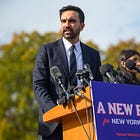Permitting Reform Alone Is No Panacea
We must tackle the regulatory barriers to building in America—but this is no miracle cure.

This is part of a new American Purpose series “Abundance in America,” in which Francis Fukuyama and other leading intellectuals explore the barriers preventing infrastructure projects in the United States, why they’re needed, and how to create a country that builds.
To ensure you don’t miss any of the essays, make sure you’re subscribed to both American Purpose and Frankly Fukuyama!
One set of ideas for reworking Democratic policies following the 2024 presidential election is the abundance agenda. A core element of this initiative is reforming permitting processes, especially pertaining to critical infrastructure projects. Until recently, this was primarily a Republican concern. The business community complained that permitting problems held up commercial development and created economic inefficiencies. However, it became clearer to Democrats after the Biden administration’s Bipartisan Infrastructure Act and Inflation Reduction Act passed that the same problems could delay, or even kill, green infrastructure projects as well.
Permitting reform causes less angst for Republicans because many of them care less about the regulatory goals behind the permits. For Democrats, on the other hand, abandoning the intent of environmental and safety regulation is not an option. Their challenge is how to navigate the need to build critical infrastructure more efficiently without undermining legitimate regulatory goals.
The permitting reform topic has been particularly contentious in California for decades. California has long had a reputation for being over-regulated and highly taxed—causing it, critics claim, to lose businesses like SpaceX, Oracle, Chevron, and the like to our nemesis state, Texas. The reality is more nuanced, but the concern about business conditions is widespread and has important implications for the state’s budget. Inside the California Democratic Party, the question often pits ardent environmentalists against centrists.
Nonetheless, California has shown that Democrats can undertake serious permitting reform if they so choose, such as putting limits on grounds on which a permit can be denied and imposing time limits on the length of a permitting process. Permitting reform is an important goal, but infrastructure projects are difficult for many reasons beyond the permitting processes. It is a necessary first step, but not a sufficient solution.
Understanding the Problem
What does over-regulated mean? To some, it means the sheer number of laws and regulations on the books. The Mercatus Center, for instance, claims that California is the most over-regulated state because its review of the state’s administrative codes 2023-24 revealed that they contained over 420,000 regulatory restrictive words, which was more than other states by orders of magnitude in several cases (e.g. Idaho, 31,000). Many of these provisions have nothing to do with economic development or the environment.
A high volume of environmental and safety regulation brings more citizen and business actions into potential play. Large infrastructure projects can fall simultaneously under the domain of local, state and federal agencies (vertical fracture) and across multiple agencies at each level of government (horizontal fracture). That means there are multiple veto points at which opposition groups can stop or delay the permitting process. Transaction costs increase with each agency that must be consulted. A mitigation deal with one agency might have to be renegotiated after consultation with another agency. A separate, serial review by multiple agencies is usually prolonged and frustrating. While it helps to put all the agency officers in the same room, it will not expedite the process if they lack final decision-making authority and must ship the ultimate approval to a higher level.
When environmentalists use veto points to stop shopping malls, this obstruction seems to them like a good idea. But when it holds up or causes the cancellation of utility-scale wind and solar farms or prescriptive burns for wildfires, it seems more problematic. As the saying goes in politics, “where you stand depends upon where you sit.”
Another factor in permit obstruction is the democratization of administrative processes. Because of well-intentioned reforms since the 1970s, regulatory decision-making has been opened up by Freedom of Information Act requirements, open meeting laws and other transparency measures. The premise of these reforms was that allowing the public to view what had previously been done in secrecy would restore confidence and legitimacy to administrative processes. In my book Democracy More or Less, I refer to this as the “more democracy is always better” assumption: i.e. that more procedural openness will improve decision-making and make it less susceptible to special interest capture. However, that is true only if the public is well informed, motivated, and participates in representative numbers—which rarely happens in administrative proceedings.
As compared to city council, state legislative, or congressional hearings, an administrative hearing typically receives less press coverage and sparse public attendance, unless a group of citizens has a specific complaint about a problem that directly affects them. Interest groups either send their lobbyists and government affairs officers or hire outside consultants to monitor the proceedings for them. Organized and well-resourced neighborhood groups might also attend when alerted, but the potential for selection bias is omnipresent with state and local administrative hearings.
At the same time, vague bill language means agencies are placed in the position of making legislative rather than purely administrative decisions. The greater the discretion allotted to agencies, the more an administrative process opens controversies the legislative body wanted to avoid. Environmental bills, for example, often allocate considerable flexibility. One defensible reason for this is an acknowledgement of the contextual variation of environmental conditions in different ecological settings. However, the raw political reason for this is to pass the hot political potato down the intergovernmental line. Handing legislative tasks to administrative agencies, for good or bad reasons, undermines issue closure. Passing an environmental bill all-too-often re-starts ongoing re-litigation over what a bill should do.
Procedural fracture and skewed participation can interact perversely in a state that clusters by wealth. Regulatory authority of stationary air pollution in California is regionally subdivided. The Central Valley CARB (a redder region and home to agribusiness and industry) is far laxer with its air pollution regulations than its Bay Area counterpart. The membership of the regional board members varies predictably across areas, with agribusiness and industry dominating in the more polluted Central Valley region and environmentalists and liberals in the Bay Area. Regional regulatory fracture results in considerable regulatory variance. Add in the differences in educational attainment and English language facility in different regions, and you get even more regulatory variance.
When it comes to green infrastructure, there can be permitting obstruction across and within party lines. Several Republican counties with ample amounts of open land for large wind and solar farms in California such as San Bernardino, Glenn and Shasta have passed measures limiting them to a few restricted areas due to noise and visual blight. In the more populated, solidly blue, coastal side of the state, the expense of the land and the same nuisance objections preclude even the mere consideration of siting them there.
Environmental groups also use permitting opportunities to delay or obstruct utility scale wind and solar to prevent potential damage to wildlife such as birds or turtles. In some ideal world, these issues would be hashed out and compromised at the legislative or electoral levels as opposed to site-by-site permitting battles. These same tensions are also fought out over permitting desalination plants, allocating surface water for aquifer replenishment, repurposing farmlands, building high speed rail, etc., keeping lawyers, economists, and consultants fully employed.
One might suppose that universities are oblivious to these issues, but that is not so. A good example of this is the problem that my university, Stanford, faced when trying to enhance protection from flooding in the San Francisquito Creek, which borders the Western side of the campus. The creek overflowed into major parts of Palo Alto in 1998, and five entities that either bordered or had jurisdiction over the creek entered into a Joint Point Powers agreement to create better physical protection from future creek flooding that will likely worsen with climate change.
After organizing itself, the Joint Powers Authority came up with plans to widen and raise the levees at the bottom of the creek to prevent it backing up onto Stanford property and other neighbors. This ultimately required state and federal approval from eight different agencies, i.e. a great deal of procedural fracture and complexity.
The process also attracted many stakeholders such as environmental groups, who were concerned about the effects of diverting the flooding into a marsh area that contained two endangered species that few people knew about; golfers who did not like how it would reconfigure the front nine of their course; justice groups who claimed to be worried that the levees on the poorer East Palo side would be several inches lower than on the wealthier Palo Alto side; and the NIMBYs who saw an opportunity to get rid of the small airport for people who needed to practice taking off and landing multiple times in a day. As a frequent hiker of the trail underneath the landing path, I could sympathize with that objection.
In the end, responding to the technical objections raised at both the state and federal levels—that often sounded like pretexts—the process went on for years at great expense. The final completion of the first part of the project was in 2019, and subsequent pieces were finished in 2024 with another due in 2026, over a quarter of a century after the initial planning started. In the meantime, the risk of flooding in the lower income East Palo Alto Area was unaddressed while all these other issues were contested. Did Democrats appreciate the problem? In the words of one writing in the Palo Alto newspaper:
In the nine years I was on the Parks and Recreation Commission, ending December 2012, I attended and participated in countless meetings about the creek and the golf course. I found it to be frustrating how protracted the process of working through all the various issues around this project was … I will remain a Democrat, but this is a classic example of a criticism that Republicans voice about the heavy hand of government getting in the way of local government best serving its local citizens.
Are there solutions to the permitting problem that do not involve gutting environmental laws? Yes. Are Democratic politicians willing to take them? Yes, sometimes. In 2014, during a drought that ultimately lasted three years, Governor Jerry Brown issued executive orders that suspended parts of the California Environmental Quality Act (CEQA) to expedite emergency regulations and temporary permits for water supply projects. But, for all the reasons that Trump has demonstrated at the national level, emergency powers should be temporary and used sparingly.
A more relevant example is two laws passed to expedite the permitting of charging stations for electric vehicles. Among other provisions, they required that permits must be automatically approved unless there is a specific, adverse impact to public health and safety (as opposed to reviews based on aesthetics or zoning); it required online applications with a task checklist, and binding timelines for permit approval.
When it did not appear that the number of level three charging stations was increasing at the hoped-for rate after the reform, the state suspected that local communities were slow-walking the permitting process. The Bill Lane Center for the American West undertook the task of investigating for the Governor’s Go-BIZ office. What we discovered was that cities were indeed trying to turn the state law into local ordinances, but the complexity of approving large projects involved multiple departments that slowed the process to some degree.
But more importantly, the real problem was the difficulty of hooking up to the grid (called “energization” in the trade). Grid congestion and coordination issues were the real reasons that permitting reform by itself could not solve the problem of creating as many level three charging stations as the state’s ambitious decarbonization goals required.
And therein lies an important caveat to the permitting emphasis that some abundance agenda advocates take. Building infrastructure has many problems and permitting is just one. There are political problems (e.g. voters are more concerned about day-to-day problems than those that affect future generations); financial problems (e.g. these are expensive projects and government commitment to them shifts with political tides); and underlying political problems (e.g. NIMBYism and partisanship) that will remain.
Permitting reform is a good thing, but it is not a miracle cure for what ails U.S. infrastructure development.
Bruce Cain is a Political Science Professor at Stanford and writes about problems of democracy and Environmental Governance.
Follow Persuasion on X, Instagram, LinkedIn, and YouTube to keep up with our latest articles, podcasts, and events, as well as updates from excellent writers across our network.
And, to receive pieces like this in your inbox and support our work, subscribe below:





